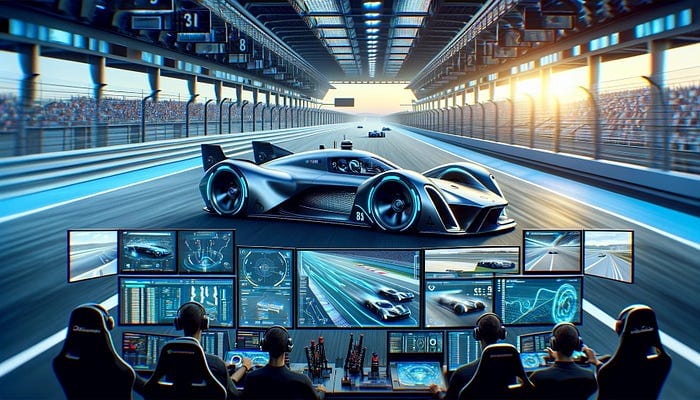Racing Towards the Future of Autonomous Vehicle Technology

Last week, one of my readers asked about how AI is being applied, not just to the self-driving cars we are all hearing about, but rather, is AI being applied to autonomous race cars? The short answer is an enthusiastic yes! Safety and performance technology in our everyday cars, trucks, and SUVs is largely a spinoff from what’s learned on the race track. This will be as true as AI finds its way to your daily driver. Today, we will have a high-level look at what’s happening in this area by looking at this cool little organization, RoboRace. https://roborace.com/
In the fast-paced world of automotive innovation, the intersection of artificial intelligence (AI) and motorsport represents a thrilling frontier. British startup Roborace is at the forefront of this revolution, challenging the conventional boundaries of technology and speed. Their mission? To create the world’s first fully autonomous racecar capable of outperforming humans in the high-stakes environment of a racetrack. This short essay explores the journey, the technological marvels behind autonomous vehicles, and the broader implications of this innovation for society.
Driving, especially racing, is not merely about maneuvering a vehicle from point A to point B. It involves a complex blend of intuition, strategic thinking, and split-second decision-making under extreme conditions. Roborace emerged with a vision to encapsulate these human qualities within the circuitry of autonomous vehicles. By pushing AI to its limits in the racing arena, Roborace aims to accelerate the development of driverless technology, making it faster, safer, and more efficient than ever before.
An intricate assembly of technologies is required to mimic human intuition and machine decision-making. Roborace’s vehicles are equipped with differential GPS systems of military-grade precision, LiDAR sensors for creating detailed 3D maps of their surroundings, and advanced vehicle-to-vehicle communication systems. These technologies enable the cars to understand their position in the world, detect obstacles, and coordinate their actions with unprecedented precision. However, the true challenge lies in integrating these data streams into a cohesive decision-making process involving complex algorithms and real-time computing power.
Roborace’s innovative approach extends to its collaborative model, inviting software companies to develop the AI drivers that pilot these futuristic vehicles. This collaboration fosters a competitive yet constructive environment, where teams like those from the Technical University of Munich and the UK startup Arrival bring their unique strategies and software solutions to the test. Through rigorous challenges, such as high-speed overtakes, these teams push the boundaries of what’s possible, contributing to the continuous improvement of autonomous driving algorithms.
The path to perfection is strewn with challenges and setbacks, as evidenced by Roborace’s testing phases. Technical glitches, connectivity issues, and the unpredictable nature of AI behavior under extreme conditions have led to crashes and near-misses. Each incident, however, provides invaluable data, helping engineers and developers refine their technologies and strategies. Pursuing autonomous racing excellence is not just about speed; it’s a meticulous learning, adaptation, and innovation process.
The implications of Roborace and autonomous vehicle technology extend far beyond the racetrack. The promise of driverless cars, buses, and trucks heralds a transformative shift in transportation, urban design, and societal functioning. With the potential to reduce accidents, improve traffic flow, and decrease emissions, autonomous vehicles could significantly impact how we live, work, and interact with our cities. Furthermore, the technology developed in the high-stakes racing environment can accelerate the adoption of autonomous systems in commercial and personal vehicles, making them safer and more efficient.
As Roborace continues to break new ground, it is a testament to AI’s potential to transcend human limits. Yet, it also highlights the importance of safety, ethics, and societal impact in developing autonomous technologies. The journey of autonomous vehicles from racetracks to city streets encapsulates a broader narrative about innovation’s role in shaping society’s future. It is a race not just against time or technology but towards a vision of a safer, cleaner, and more efficient world.
Roborace represents the cutting edge of autonomous vehicle technology, driving forward AI capabilities in a domain traditionally dominated by human skill and intuition. As this technology continues to evolve, it promises to revolutionize motorsport and redefine our relationship with transportation. The race towards the future of autonomous driving is ongoing and promises to be transformative.
Join Us Towards a Greater Understanding of AI
I hope you found insights and value in this post. If so, I invite you to become a more integral part of our community. By following us and sharing our content, you help spread awareness and foster a more informed and thoughtful conversation about the future of AI. Your voice matters, and I’m eager to hear your thoughts, questions, and suggestions on topics you’re curious about or wish to delve deeper into. Together, we can demystify AI, making it accessible and engaging for everyone. Let’s continue this journey towards a better understanding of AI. Please share your thoughts with me via email: marty@bearnetai.com, and don’t forget to follow and share BearNetAI with others who might also benefit. Your support makes all the difference.
Thank you for being a part of this fascinating journey.
BearNetAI. From Bytes to Insights. AI Simplified.
Categories: Technology and Innovation, Artificial Intelligence and Robotics, Automotive and Motorsport, Engineering and Computer Science, Future of Transportation, Ethics and Society
The following sources are cited as references used in research for this BLOG post:
Autonomy: The Quest to Build the Driverless Car — And How It Will Reshape Our World by Lawrence D. Burns with Christopher Shulgan.
The Driver in the Driverless Car: How Our Technology Choices Will Create the Future by Vivek Wadhwa and Alex Salkever.
How to Build a Robot Army: Tips on Defending Planet Earth Against Alien Invaders, Ninjas, and Zombies by Daniel H. Wilson.
Machine, Platform, Crowd: Harnessing Our Digital Future by Andrew McAfee and Erik Brynjolfsson.
Robotic Futures by Illah Reza Nourbakhsh.
Engines of Tomorrow: How the World’s Best Companies Are Using Their Research Labs to Win the Future by Robert Buderi.
© 2024 BearNetAI LLC